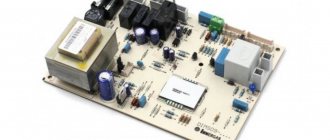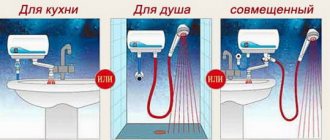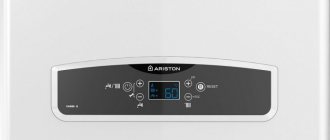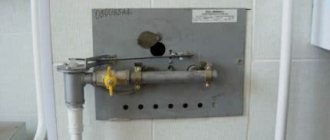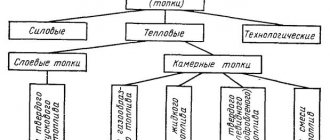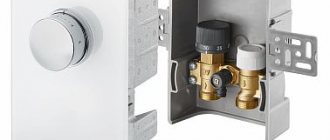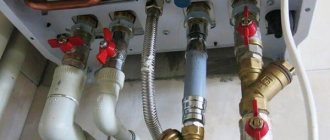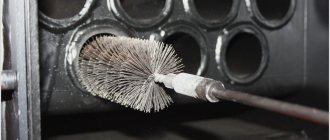Operating principle of a condensing boiler
The condensing boiler is the younger brother of the most common gas-fuel convection boiler. The principle of operation of the latter is extremely simple, and therefore understandable even to people who are poorly versed in physics and technology. The fuel for a gas boiler, as its name suggests, is natural (main) or liquefied (cylinder) gas. When blue fuel is burned, like any other organic matter, carbon dioxide and water are formed and a large amount of energy is released. The released heat is used to heat the coolant - process water circulating through the heating system of the house.
The efficiency of a gas convection boiler is ~90%. This is not so bad, at least higher than that of liquid and solid fuel heat generators. However, people have always strived to bring this figure as close as possible to the coveted 100%. This raises the question: where does the remaining 10% go? The answer, alas, is prosaic: they fly down the drain. Indeed, the gas combustion products leaving the system through the chimney are heated to a very high temperature (150-250°C), which means that the 10% of energy we lose is spent on heating the air outside the house.
Scientists and engineers have long been looking for the possibility of more complete heat recovery, but a way to technologically implement their theoretical developments was found only 10 years ago, when a condensing boiler was created.
What is its fundamental difference from a traditional convection gas-fuel heat generator? Having completed the main process of fuel combustion and transferring a significant part of the heat released to the heat exchanger, the condenser cools the combustion gases to 50-60°C, i.e. to the point where the water condensation process begins. This alone is enough to significantly increase the efficiency, in this case, the amount of heat transferred to the coolant. However, that's not all.
Traditional gas boiler
Condensing gas boiler
At a temperature of 56°C - at the so-called dew point - water changes from a vapor state to a liquid state, in other words, water vapor condenses. In this case, additional energy is released, which was previously spent on water evaporation and, in conventional gas boilers, is lost along with the evaporating steam-gas mixture. A condensing boiler is able to “take away” the heat generated during the condensation of water vapor and transfer it to the coolant.
Manufacturers of condensing-type heat generators invariably draw the attention of their potential customers to the unusually high efficiency of the devices they produce - above 100%. How is this possible? In fact, there is no contradiction to the canons of classical physics here. It’s just that in this case a different calculation system is used.
Often, when assessing the efficiency of heating boilers, they calculate how much of the released heat is transferred to the coolant. The heat “recovered” in a conventional boiler and the heat from deep cooling of the flue gases will give a total of 100% efficiency. But if we add here the heat released during steam condensation, we get ~108-110%.
From a physics point of view, such calculations are not entirely correct. When calculating efficiency, it is necessary to take into account not the released heat, but the total energy released during the combustion of a mixture of hydrocarbons of a given composition. This will also include the energy spent on converting water into a gaseous state (later released during the condensation process).
It follows from this that an efficiency coefficient exceeding 100% is just a cunning move by marketers exploiting the imperfections of the outdated calculation formula. However, it should be recognized that the condenser, unlike a conventional convection boiler, manages to “squeeze” everything or almost everything out of the fuel combustion process. The positive aspects are obvious - higher efficiency and reduced consumption of fossil resources.
Boiler location
The design of a gas boiler with a forced supply of an air mixture allows it to be placed in almost any room, since it does not take air from the room and is equipped with a closed combustion chamber. This allows you to install the unit, for example, in the kitchen. It is better when it is located near the outer wall, so that you do not have to make a long horizontal section of the chimney. Depending on the interior, you can choose a wall-mounted boiler, fitting it between household appliances, or a floor-standing version. For example, the external design of the floor-standing condensing unit Vitodens 222 - F from Viessmann is perfect for the kitchen, as it looks like a large refrigerator.
Before purchasing, you should carefully study all condensing boilers of a particular manufacturer, not only for power, but also for design. Both wall-mounted and floor-mounted units from different brands have a wide range of capacities. A wall-mounted unit can be purchased from 3.5 to 110 kW of thermal power, which will allow you to heat several rooms or a three-story cottage. The power of household floor-standing installations is even greater - up to 320 kW.
If you need to provide heating of water for household needs, it makes sense to purchase a double-circuit gas condensing boiler. It should be selected according to the number of hot water consumers. Units with a flow-through heat exchanger can provide 2-3 consumers, but if their number is larger, it is worth considering the option with a built-in boiler.
Having determined the installation location of the boiler, you need to make sure that it is possible to connect a chimney to it. The simplest option is to route the pipe horizontally through the outer wall; this option is suitable for a one-story house. For two or more floors, it may become unacceptable, since smoke can be blown into the windows of the upper rooms by the wind. Here it is better to install a traditional vertical chimney. Some manufacturers sell chimney parts as part of their boiler installations.
Construction of the main components of a condensing boiler
From a structural point of view, a condensing boiler is not very different, but still different from a conventional gas boiler. Its main elements are:
- a combustion chamber equipped with a burner, a fuel supply system and a fan for forcing air;
- heat exchanger No. 1 (primary heat exchanger);
- chamber for additional cooling of the vapor-gas mixture to a temperature as close as possible to 56-57°C;
- heat exchanger No. 2 (condensation heat exchanger);
- condensate collection tank;
- chimney for removing cold flue gases;
- a pump that circulates water in the system.
1. Chimney. 2. Expansion tank.
3. Heat transfer surfaces. 4. Modulating burner.
5. Burner fan. 6. Pump. 7. Control panel.
In the primary heat exchanger connected to the combustion chamber, the released gases are cooled to a temperature significantly above the dew point (in fact, this is what conventional convection gas boilers look like). Then the smoke mixture is forced to the condensation heat exchanger, where it is further cooled to a temperature below the dew point, i.e. below 56°C. In this case, water vapor condenses on the walls of the heat exchanger, “giving up the last.” The condensate is collected in a special tank, from where it flows down the drain pipe into the sewer.
Water, which acts as a coolant, moves in the direction opposite to the movement of the vapor-gas mixture. Cold water (heating system return water) is preheated in a condensing heat exchanger. It then enters the primary heat exchanger where it is heated to a higher temperature set by the user.
Condensate, alas, is not pure water, as many believe, but a mixture of dilute inorganic acids. The concentration of acids in the condensate is low, but given that the temperature in the system is always elevated, it can be considered an aggressive liquid. That is why in the production of such boilers (and primarily condensing heat exchangers), acid-resistant materials are used - stainless steel or silumin (aluminum-silicon alloy). The heat exchanger, as a rule, is made cast, since the welds are a vulnerable point - this is where the process of corrosive destruction of the material first begins.
The steam must condense on the condensation heat exchanger. Everything that passes further into the chimney, on the one hand, is lost for heating, and on the other, has a destructive effect on the chimney material. It is for this last reason that the chimney is made of acid-resistant stainless steel or plastic, and its horizontal sections are given a slight slope so that the water formed by the condensation of small amounts of steam that still enter the chimney is drained back into the boiler. It should be taken into account that the flue gases leaving the condenser are very cooled, and everything that has not condensed in the boiler will certainly condense in the chimney.
At different times of the day, different amounts of heat are required from the heating boiler, which can be adjusted using a burner. The burner of a condensing boiler can be either modulating, i.e. with the ability to smoothly change power during operation, or unmodeled - with fixed power. In the latter case, the boiler adapts to the owner’s requirements by changing the burner switching frequency. Most modern boilers intended for heating private homes are equipped with modulating burners.
So, you hopefully have a general idea of what a condensing boiler is, how it works and on what principle it works. However, most likely, this information will not be enough to understand whether you personally should purchase such equipment. To help you make this or that decision, we will tell you about all the advantages and disadvantages, pros and cons of a condensing boiler, comparing it with a traditional convection boiler.
Disadvantages of use
With a fairly large number of advantages, there are also some features or, relatively speaking, disadvantages that should be taken into account when choosing, installing and servicing condensing boilers:
- Insufficiently high temperatures for heating the air masses in the heated room. This feature is associated with the ratio of the supply and return temperature of the coolant - 55°C to 35°C, which is very effective only when installing a “warm floors” system. The use of a condensing boiler in a traditional heating system will require the installation of several additional radiators.
- During the operation of a condensing heating device, it becomes necessary to ensure the disposal of all emitted condensate, which contains a certain amount of toxic acid. The chemical composition of such condensate does not allow the use of local sewer systems, such as traditional septic tanks, for drainage.
When installing a heating system using a condensing boiler, a separate system must be provided at the design stage to effectively neutralize condensate.
Condensing boiler efficiency
Operation of equipment with a power of no more than 35 W in the presence of a centralized sewer system will not require the installation of an additional outlet neutralizer.
One of the main disadvantages of any modern condensing boilers, according to the majority of domestic consumers, is still the fairly high cost of such heating equipment.
Advantages of a condensing boiler
The list of advantages of a condensing boiler is impressive, which ultimately explains the growing popularity of this type of heating equipment:
- Fuel savings compared to a conventional convection boiler can reach 35%.
- The reduction in harmful emissions when switching from traditional gas models to condensing ones is estimated at an average of 70%.
- The low temperature of the exhaust gases makes it possible to install plastic chimneys, which are much cheaper than classic steel ones.
- Low noise level increases the level of comfort of people living in the house.
Let's talk about some of the listed advantages of condensing boilers in more detail.
Fuel savings when used in low temperature systems
Fuel consumption directly depends on the power of the equipment and the load placed on the heating system. To heat a house with an area of 250 m2, a 28-kilowatt condensing boiler with a maximum gas flow of 2.85 m3/h will be sufficient. A classic boiler of the same power will consume 3.25 m3/h. Provided that the boiler is used for six months out of twelve, you will save about 3,000 rubles per year. (at current prices for main gas for Russian consumers). Such savings, probably, can hardly be called significant - it will not even cover the difference in the cost of annual boiler maintenance.
But let's look at the situation through the eyes of the average European consumer, for whom natural gas costs four to five (or even more) times more. The amount of savings in this case will be about 300 euros, and it’s worth fighting for.
Gas consumption in condensing boilers of various capacities:
Reducing harmful emissions
When fossil fuels burn, carbon dioxide is formed, which produces carbon dioxide when it reacts with water. In addition, any fuel always contains impurities of sulfur compounds, phosphorus, nitrogen and a number of other elements. During combustion, the corresponding oxides are formed from them, which, when combined with water, also produce acids.
In conventional convection boilers, water vapor mixed with acids (carbonic, sulfuric, nitric, phosphoric) are released into the atmosphere. Condensing boilers do not have this drawback: acids remain in the condensate. However, given the problems with condensate disposal, the notorious environmental friendliness of this equipment may be called into question.
Top 5 condensing gas boilers by rating
The preferred gas condensing boiler unit is one that meets the urgent needs of the home owner in terms of thermal energy production, is equipped with modern automation for economical and safe operation, and has an affordable price.
It is important to note that condensing boilers do not have the concept of “low price”; they initially have a high cost due to the use of high-strength materials.
BAXI LUNA Platinum+ 1.32
This is a gas condensing floor-standing boiler from a well-known Italian manufacturer. The boiler unit is single-circuit, designed exclusively for heating.
Advantages of modification:
- Ultra-high efficiency - 105.7%.
- Heating area up to 350 m2.
- Heating capacity - 35 kW.
- Low specific fuel consumption, maximum gas consumption is not higher than 3.49 m3/hour.
- Fuel versatility, works with any type of gas - mainline/liquefied.
- Full-featured protection.
- Pre-cleaning of condensate.
- Pre-cleaning of feed water - built-in filter.
- Price: 83420 rub.
Disadvantages of the Baxi floor-standing condensing boiler:
- works only with low-temperature coolants in the “warm floor” system;
- high price;
- Sold only to order, long delivery period.
Buderus Logamax plus GB062-24 KD
Also a condensing boiler from a German company. A model with a heating output of 24 kW designed for heating residential buildings.
Advantages of modifying Buderus condensing boilers:
- Ultra-high efficiency - 103.0%.
- Heating area up to 250 m2.
- Heating capacity - 24 kW.
- Low specific fuel consumption, maximum gas consumption is not higher than 3.18 m3/hour.
- High-quality construction materials, durability of the boiler.
- High level of automation and control of the performance of installation components.
- Price: 63,700 rub.
The disadvantages of the boiler unit are the high cost of the boiler and repair work.
Bosch Condens 2500W WBC 24-1
Turkish double-circuit gas boiler with heating capacity - 24 kW.
Advantages of modification:
- Ultra-high efficiency - 110.0%.
- Heating area up to 192 m2.
- Thermal heating capacity is 24 kW.
- Low specific fuel consumption, maximum gas consumption is not higher than 3.18 m3/hour.
- High-quality construction materials, long service life of the boiler.
- High level of automation and control of thermal processes.
- Expansion tank - 6 l.
- Price: 89670 rub.
Disadvantages of a Bosch condensing boiler:
- inaccessibility to work on liquefied gas;
- high cost of the boiler and repair work.
Vaillant ecoTEC plus VU INT IV 246/5-5
The German brand Vaillant, a leader in the production of household heating boilers, produces a single-circuit condensing model ecoTEC plus VU INT IV 246/5-5 with a steel heat exchanger. The boiler is designed for heating residential and public premises up to 200 sq.m.
Advantages of the Vaillant boiler:
- Ultra-high efficiency - 108.0%.
- Heating area up to 200 m2.
- The heating capacity is 20 kW.
- Low specific fuel consumption, maximum gas consumption is not higher than 2.6 m3/hour.
- High-quality construction materials, durability of the boiler.
- Remote control.
- High level of automation and performance monitoring of installation components
- Expansion tank - 10 l.
- Price: 62270 rub.
The disadvantages of the boiler unit are the high cost of the boiler and repair work.
Viessmann Vitodens 100-W B1HC043
Another German single-circuit condensing boiler unit. Powerful model - develops up to 35 kW and is capable of heating 350 sq.m.
Viessmann Vitodens boiler. Photo source: ferencziepuletgepeszet.hu
Advantages of the Viessmann boiler:
- Ultra-high efficiency - 108.7%.
- Heating area up to 350 m2.
- Thermal heating capacity is 35 kW.
- Low specific fuel consumption, maximum gas consumption is not higher than 3.46 m3/hour.
- High-quality construction materials, durability of the boiler.
- Remote control.
- High level of automation and control of combustion processes.
- Price: 105806 rub.
The disadvantages of the boiler unit are the high cost of the boiler and repair work.
Cons of a condensing boiler
A condensing boiler, for all its advantages, cannot be called an ideal heating equipment, because it is not without its disadvantages:
- high price;
- high cost of the heat exchanger (and, as a consequence, the need to carefully monitor the condition of the entire heating system);
- inappropriate for use in high-temperature systems;
- difficulty in condensate disposal;
- sensitivity to the quality of intake air.
Price
You have to pay for the additional percentage of thermal energy. Technically, a condensing boiler is more complex and therefore more expensive. The cost of a good household condenser from a well-known manufacturer is several times higher than the cost of a classic unit of the same power. Of course, such equipment is purchased for more than one decade, which means it makes sense to give preference to innovative technologies that increase operating comfort.
Conventionally, all models of condensing boilers can be divided into three price categories - premium, middle and economy class:
1. Premium class is designed for a few buyers. Premium condensing boilers include, for example, models from German brands. This equipment is efficient and convenient to use, meets European environmental standards, and is made of high quality materials.
“Premium” boilers have many useful functions that significantly increase the level of comfort during their operation: programming operating modes (for example, maintaining the room temperature at a minimum level in the absence of owners or slightly reducing the temperature at night), weather-dependent regulation, intelligent interaction with other heat generators , remote control using a special program on a mobile phone, etc. The only negative is the high price.
2. The middle class includes cheaper goods, but with somewhat more modest consumer qualities. These are economical and environmentally friendly units that meet all requirements and provide high performance. They are distinguished by a wide range of functions and are equipped with an automatic control system that independently changes parameters depending on the temperature of the coolant and air in the room.
3. Economy class is designed for those who, for the sake of saving money, are willing to put up with a lower level of comfort. “Mass” products always lead in terms of sales. The leading positions in the market of economy class condensing boilers belong to Korean and Slovak companies. Their products are two or more times cheaper than premium models. Another advantage of this equipment is its adaptability to Russian operating conditions. Inexpensive condensers with simple functionality can easily withstand power outages and pressure drops when expensive automation stops working.
When assessing your financial capabilities, you need to take into account the inevitable costs of installing and putting equipment into operation, which will also cost you very, very expensive.
We should not forget that during operation a condensing boiler provides gas savings. However, this saving is so illusory that the investment will not pay off soon. This means that before purchasing condensing heat, it is worth making a preliminary assessment: whether the cost of saved fuel justifies the high price of the equipment.
A positive economic effect from purchasing such a boiler should be expected only under certain conditions - if it is installed in a new (read “under construction”) house designed for permanent residence with an organized low-temperature heating system for heated floors. Moreover, the magnitude of the effect directly depends on the average winter temperature, i.e., on the region where the house is located (the principle is simple: the more heat required, the more sense there is in such a technique).
High cost of the heat exchanger used
The heat exchanger is a technically complex and expensive element. If it fails, you, as they say, “get paid.” For the money that you spend on buying a new heat exchanger and paying for the labor to replace it, you could easily buy a new convection boiler of the same power.
It follows from this that it is necessary to carefully monitor the condition of the heat exchanger. It will be extremely difficult to wash it out when it becomes clogged. When installing a condensing boiler, it is necessary to inspect the entire heating system - there should be no rusty pipes and radiators in it.
The safety of the heat exchanger also depends on the quality of the coolant used. The water must be soft, otherwise the tubes will quickly become overgrown with scale from the inside. The presence of rust, foreign matter, calcium and iron salts in the water is unacceptable.
Since condensate contains acids, the heat exchanger must be able to withstand their effects. Most often, heat exchangers are made of silumin and high-quality stainless steel. A silumin heat exchanger is produced using a casting method. Due to the lower cost of material and production technology, these heat exchangers are cheaper compared to stainless steel heat exchangers. But these heat exchangers also have a drawback - they are less resistant to aggressive acidic environments.
Stainless steel heat exchangers are produced by welding individual parts. The final cost of such heat exchangers is higher than silumin ones. However, they better withstand acidic environments and add reliability to the equipment.
Inappropriate for use in high temperature systems
The promised efficiency of 108-110% cannot always be achieved - the real figure depends on the heating system. There are two fundamentally different types of heating systems - high-temperature and low-temperature. They differ in the temperature range of the coolant at the inlet and outlet of the heat generator.
In conventional high temperature heating systems, the ratio of supply water to return water temperature is usually 75-80°C to 55-60°C. A system with a condensing boiler is only effective in low temperature conditions, i.e. when the ratio of supply and return temperatures is 50-55°C to 30-35°C. This ratio is ideal if the home is heated using heated floors. Otherwise, to warm the room, it will be necessary to install additional radiators with a useful surface area increased by 2.5-3 times, designed for a coolant temperature not exceeding 50°C.
The operating efficiency of a condensing boiler is determined primarily by the inlet temperature of the coolant. This is explained simply: the lower the water temperature in the return circuit, the more intense condensation occurs. The boiler efficiency in a low-temperature heating system (inlet/outlet temperature is approximately 30/50 °C) can reach the same 108-110%. If such a boiler is forced to operate in a high-temperature system (60/80 °C), then there will be no condensation, and the efficiency will drop to 98-99% - this is more than that of conventional convection boilers, but less than it could be.
Thus, if you want to get the maximum benefit from a condenser, the decision to install it must be made at the design stage of the house. If you purchase such a boiler for an existing house with an existing heating system, this means the inevitable reconstruction of the building with the replacement of a high-temperature radiator heating system with a low-temperature underfloor heating system (and such a large-scale renovation is again a considerable expense, and the economic effect of the whole undertaking is lost).
Difficulty in disposing of condensate
Using a condensing boiler involves recycling condensate. Moreover, the latter is formed in considerable quantities - one liter from a cubic meter of burnt gas. For example: a boiler with a capacity of 25 kW per hour consumes about 2.8 m3 of gas, i.e. in just one hour of its operation a little less than 3 liters of condensate will be released, and in a day - 70 liters.
Let us remember that condensate is a solution of acids, which means that the question of where to put it is not at all idle. It's good if your house is connected to a centralized sewerage system. Even according to strict European standards, boilers with a capacity of up to 28 kW do not require special condensate disposal. It is assumed that this amount of condensate is sufficiently diluted with domestic wastewater so as not to harm the sewer pipes.
But what should owners of private houses with autonomous sewage systems do? You can’t pour it into a septic tank - beneficial (and expensive) bacteria will die. It is unacceptable to drain onto the ground - the soil will become salinized, and over time nothing will grow in this place. It is extremely difficult to take out 70 liters for recycling every day. There is only one way out - to provide your own separate system for neutralizing the acids contained in the condensate. In the West, where the requirements for compliance with environmental standards are more stringent than ours, when installing a condensing boiler, a catalytic converter is automatically purchased.
Design Features
Since the condensate that falls contains acid impurities, heat exchangers for heating units are made of stainless steel. The coolant from the return pipeline is supplied to the coil; its turns form a ring, inside of which the gas burner device is located. Ideally, it also has a cylindrical shape, the nozzle holes are located over the entire surface of the burner and the flame spreads in all directions. In this way, the entire coil is heated, water vapor actively condenses on the first half of the coils, where the coolant has a low temperature.
For condensation to form, a temperature of 59 ºC or lower is required. In heating systems, the water temperature in the return pipeline ranges from 30 to 60 ºС, which is quite acceptable. A diagram of the main components that make up a wall-mounted gas condensing boiler is shown in the figure.
The combustion chamber is a closed type, with forced injection of combustion air. Since the fan is the noisiest element of the structure, low-noise models are used for condensing units; the sound of their operation is practically inaudible. Air is drawn in through the outer channel of a double-walled coaxial chimney. At the same time, flue gases come out towards it through the internal channel, giving off heat through the metal wall. The gas temperature at the outlet of the condensing boiler is less than 100 ºС.
Advice for choosing a boiler
I really want to take advantage of technological advances and throw less heat into the chimney, as happens if you use a regular convection boiler. Using a modern condensing boiler you can save up to 25% on gas costs. But when choosing such a boiler, you simultaneously expect higher maintenance costs and a shorter service life, if you compare it with a cast-iron floor-standing boiler.
How to choose right?
You just need to calculate everything. Everything in this problem is calculated mathematically. But some data may simply be unknown to you and difficult to access. To take into account all the factors, you will need numbers that are available to people and companies who have hundreds of completed projects for gas heating of objects of various types and sizes. In general, everything is considered better if your project is handled by professionals. For example, those who work in the design department of a company with more than 10 years of experience in the sale and installation of boiler equipment.
Comments on the article
(0)
Combustion process
When considering the operating principle of condensing boilers, it makes sense to start with what generally causes the heating of the coolant in this equipment - fuel combustion. The main chemical elements involved in the combustion process of any hydrocarbon fuel:
- Carbon (C), hydrogen (H2), sulfur (S) are contained in fuel. The sulfur content can be quite high in diesel or solid fuels (wood, coal). For natural gas, the maximum hydrogen sulfide content according to the standards is 20 mg/m3; the actual content is usually much less.
- Oxygen (O2), nitrogen (N2) are found in the air. There are also other gases in the air, but they are either inert or their percentage is extremely small.
Next, we will consider combustion using the example of the simplest hydrocarbon - methane (CH4). Strictly speaking, this reaction is a rather complex chain with the formation of intermediate compounds; we present the final formula:
CH4+2O2 ? CO2+2H2O+Q
The reaction occurs with the release of energy and the formation of carbon dioxide and water. The important point here is that if there is a lack of oxygen in the reacting mixture, in addition to carbon dioxide, carbon dioxide (CO) is also formed, which is dangerous for humans even in relatively low concentrations. In addition, this reduces the amount of energy received. To prevent this effect, there are certain features in the design of boiler elements, which we will discuss later.
Another important group of reactions during the combustion of methane in air is the oxidation of nitrogen and sulfur:
N2+O2 = { NO | NO2 | N2O}
S+O2 = { SO2 | SO3}
The nitrogen oxides NO and NO2 are usually referred to by the common name NOx. When reacting with water, they form nitric (HNO3) and nitrous (HNO2) acids. When released into the atmosphere, the latter become one of the main components of acid rain. Nitrous oxide N2O does not form acids, but is involved in the destruction of the ozone layer. Naturally, in the design of modern boilers, measures are taken to reduce these emissions. We will consider these measures when discussing individual hardware components.
Sulfur oxides react with water to form sulfuric acid. But their content in combustion products is extremely small, so they are not considered as a factor in environmental pollution. But they can have a strong impact on the elements of the condensing boiler.

